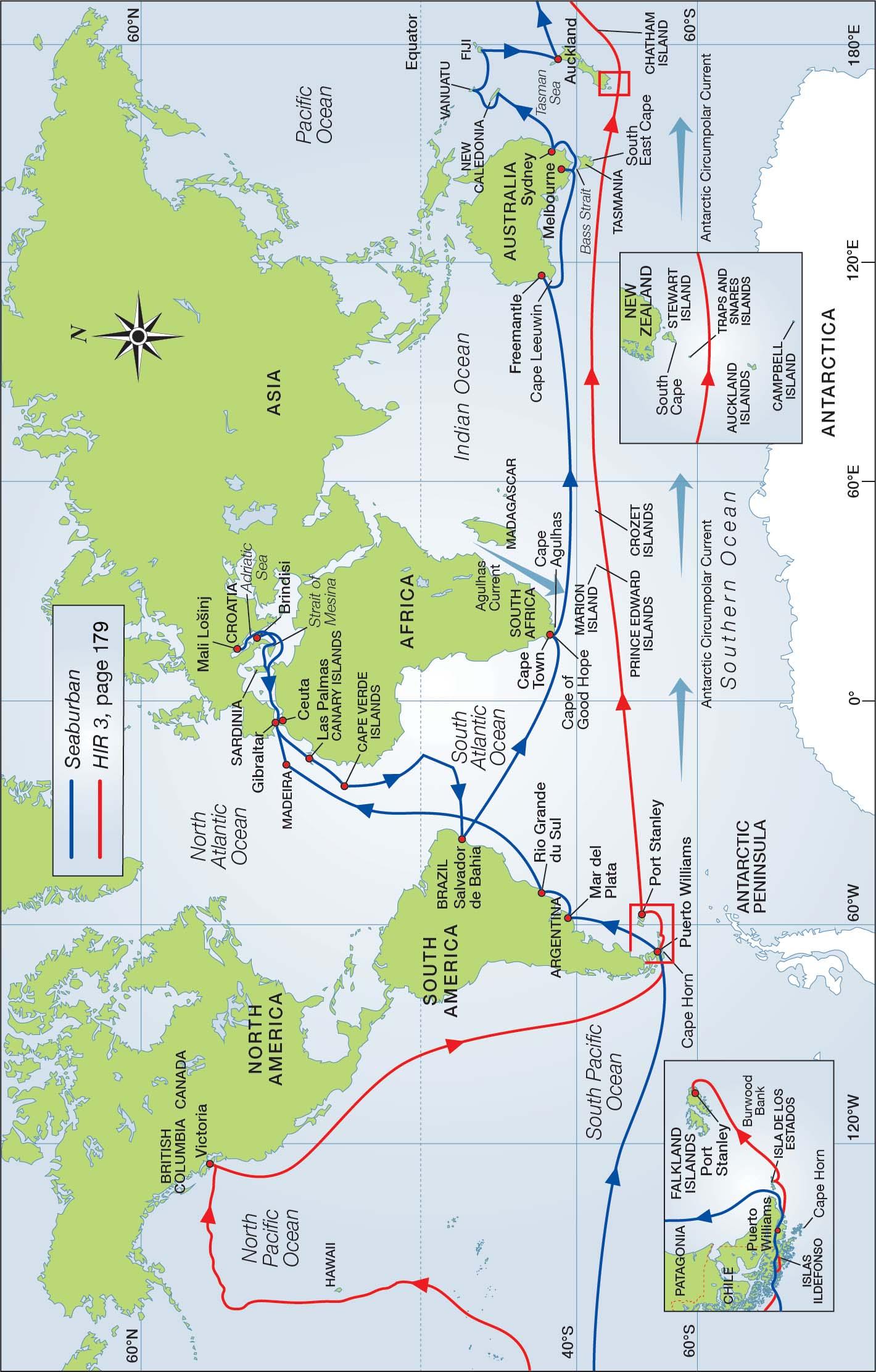
16 minute read
SEABURBAN AROUND ALONE, PART 2 Bert ter Hart
(Flying Fish 2020/1 followed Bert and his 45ft Seaburban from Victoria, British Colombia down to the Southern Ocean – the first part of his planned circumnavigation via the Five Great Capes navigating only by traditional means. We left him becalmed on the Burwood Bank near Cape Horn...
Bert was awarded the Barton Cup for 2020 in recognition of his achievement.)
First to Last: Cape Horn to South Cape, January–April 2020
Becalmed on Burwood Bank, the enormity of traversing the southern Atlantic, Indian, Tasman and Pacific Oceans sank in. For the previous two months the Horn had occupied nearly every waking moment. Slowly but surely, I came to grips with the realisation that the real work of the circumnavigation was yet to begin.
I had been more than lucky with the weather prior to rounding the Horn, but that luck looked to change for the worse after leaving Burwood Bank and approaching the Falklands. This was confirmed when I was unable to clear the shoals and currents lying to the north and east of the Falklands before an extremely severe storm swept through the South Atlantic. With steering issues compounding every day, I made the decision to seek refuge and anchor in Stanley Harbour.
Despite sustained winds of 60+ knots, gusts well beyond and a 2m chop, Seaburban somehow managed to stay anchored. I had left her usual complement of ground tackle at home, thinking there would be no need for 85lb hurricane anchors and 100m of heavy chain. What I did bring I cobbled together and, despite fore-reaching wildly about the anchorage, we stayed put ... but just barely. At 0315 on the last night of the blow, unable to keep station and dragging shoreward ignominiously towards the local graveyard, I called Stanley Harbour Control on the VHF to let them know things weren’t going as planned. No one answered.
I had reserved the last 10m of rode to be deployed in case of emergency, and could think of no greater emergency than that at hand. Up on deck and making my way forward, my only view of the situation was of the deck as I crawled, head-down, towards the bow. Whether the extra rode kept me off the rocks I can’t say, but
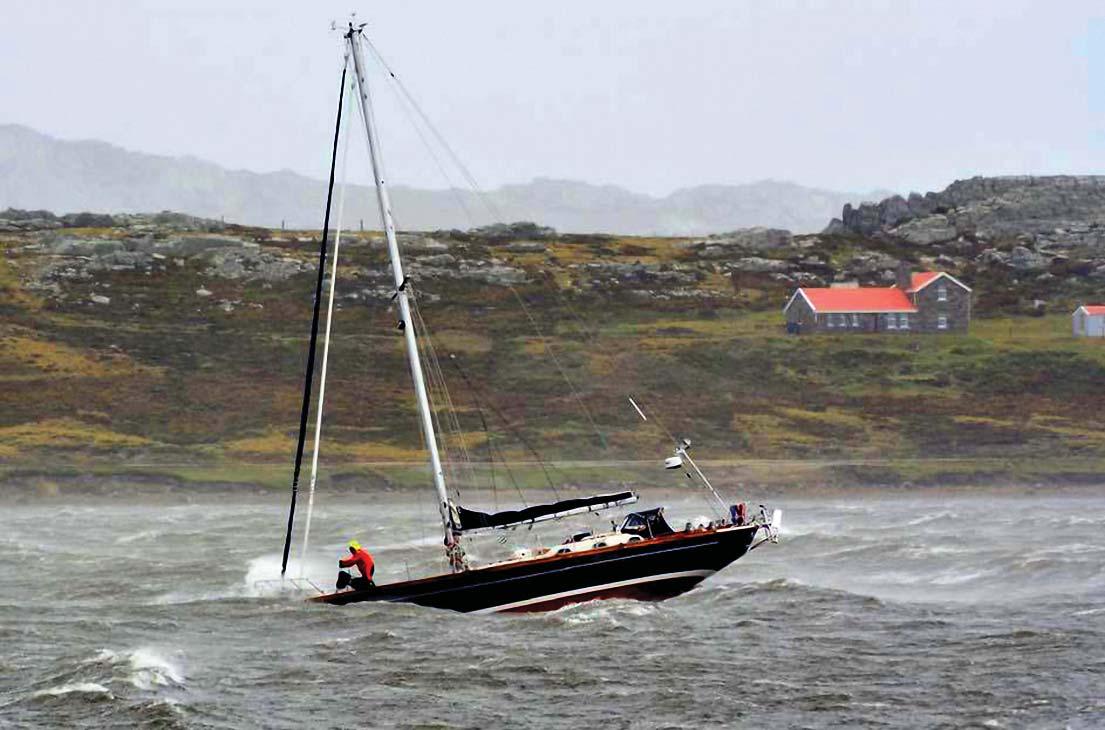
Minus her normal complement of ground tackle, Seaburban hangs by a thread in Port Stanley.
Photo R Goodwin

Departing Port Stanley, the obligatory radio call to the Port Captain drew a long silence when I announced my next port of call as Victoria, Canada, east-bound via the remaining Great Capes.
Photo G Munro
within a few hours the sound of the wind in the rigging ceased to be that of a freight train thundering across the Canadian prairie.
Leaving Stanley and determined to get east, the only option was north. East and south were impossible, west was out of the question, and north became north-by-west before foul weather to the south finally moved off enabling me to set a course across the South Atlantic.
My plan for the southern Atlantic and Indian Oceans was simple – avoid the seamounts centred around 42°S 0°W, give the Agulhas Current as wide a berth as possible and, come what may, do everything humanly possible to stay in the deep oceanic waters north of Marion and Prince Edward Islands. The Southwest Indian Ridge is discontinuous between 35° and 40°E and I felt that the rising, tortured seabed was in no small part responsible for the horrific conditions for which the southern Indian Ocean is infamous. Add in a variable current resulting from eddies spun off the Agulhas Current opposing the prevailing winds and you’ve got a recipe for disaster. I wanted no part of any of the above and to get east of the Crozet Islands as fast as possible.
I had not given much thought to typhoons spinning their way south into the Roaring Forties. Not counting Stanley Harbour, the only one I had given any thought to had been months ago in the Eastern Tropical Pacific. None, I thought, frequented the Roaring Forties, let alone that patch of ocean north and east of the Crozets. Squeezed between a tropical storm bearing down on my track and the now ubiquitous gales and storms parading eastward, I once again pointed Seaburban north. Cursed north. Above 40°S, Moitessier’s warnings of Vito Dumas’s problems began to ring in my ears. Days later, standing in the cockpit under an impossibly blue sky lording over an azure sea crowned with whitecaps, I put Seaburban’s helm hard over, tacked, and set a course south-southwest. Finally. It was 45°S or bust.
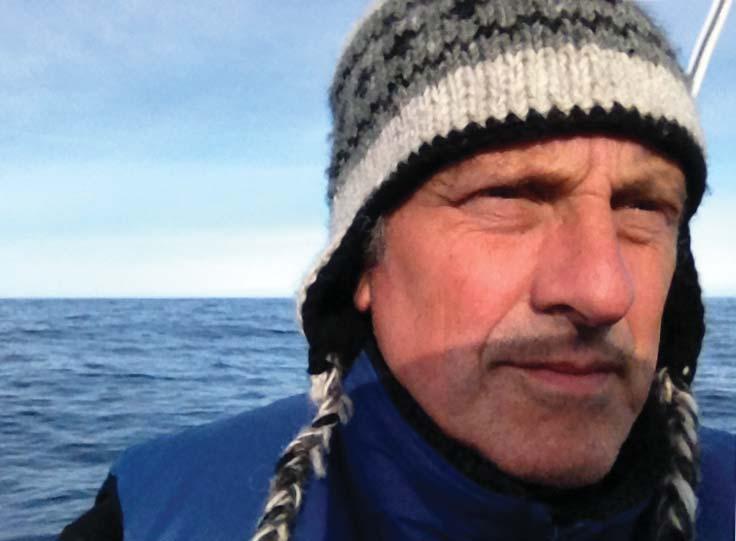

Desperate to get east after leaving the Falklands, I am forced north by severe gales and storms tracking along 45°S

Gales and calms pile on with clockwork-like efficiency. Seaburban drifts aimlessly while becalmed on a confused and restless ocean. All in all, I was becalmed for more than 50 days during my circumnavigation
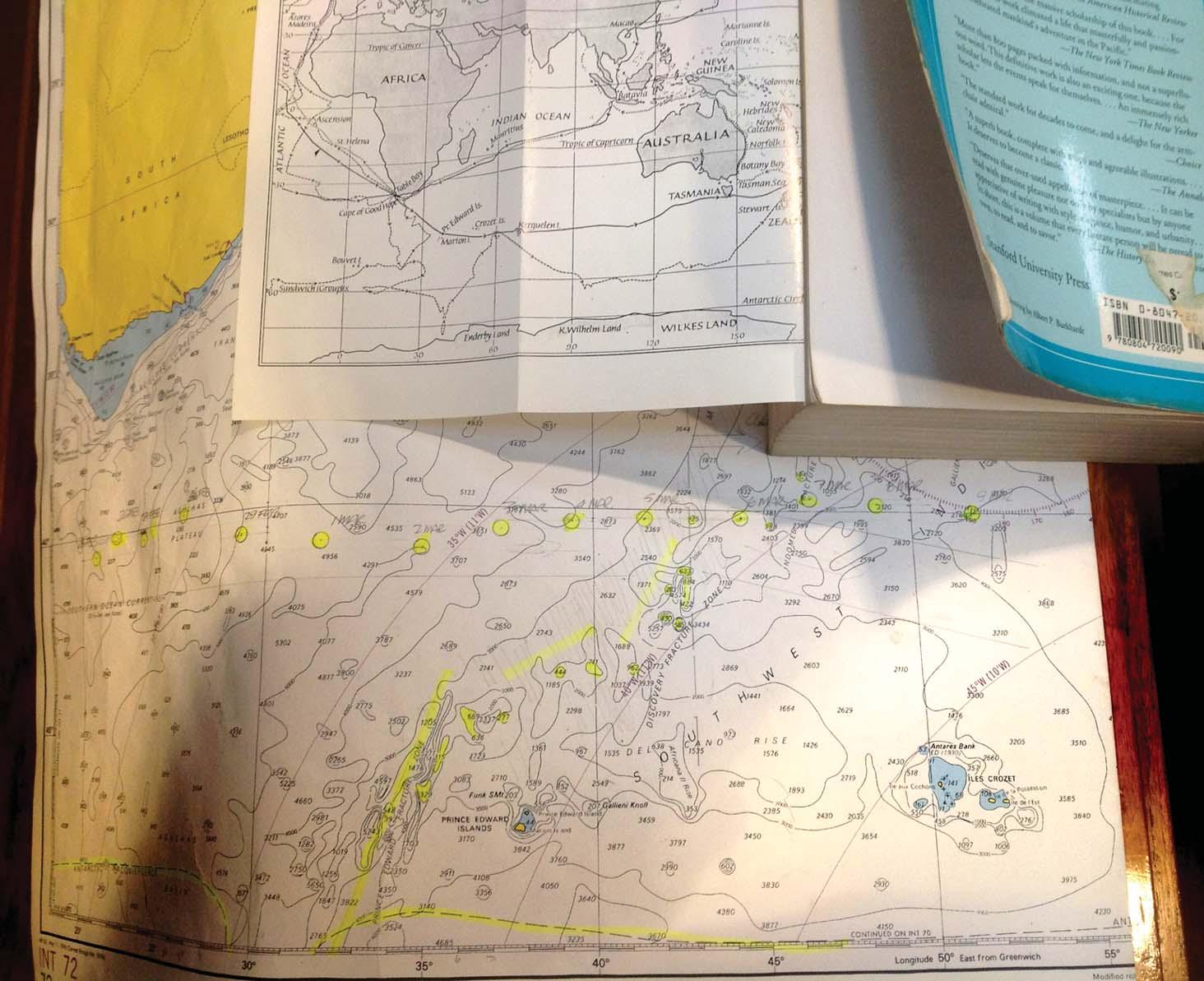
My track over the tortured bottom topography north of Prince Edward and Marion Islands and west of the Crozets. I constantly marvelled at Cook’s astonishing ability to range about the place, illustrated on a page of JC Beaglehole’s ‘The Life of Captain James Cook’, the definitive autobiography
The Last: South Cape, 28th April 2020
‘Battle-hardening’ is how Tony Gooch had referred to my transit of the south Tasman Sea. The Austral autumn had provided much the same weather that we experience in November and December in the Pacific Northwest – storm upon gale with little or no reprieve.
The weather had worsened consistently and without mercy since passing Cape Leeuwin but, having been forced north
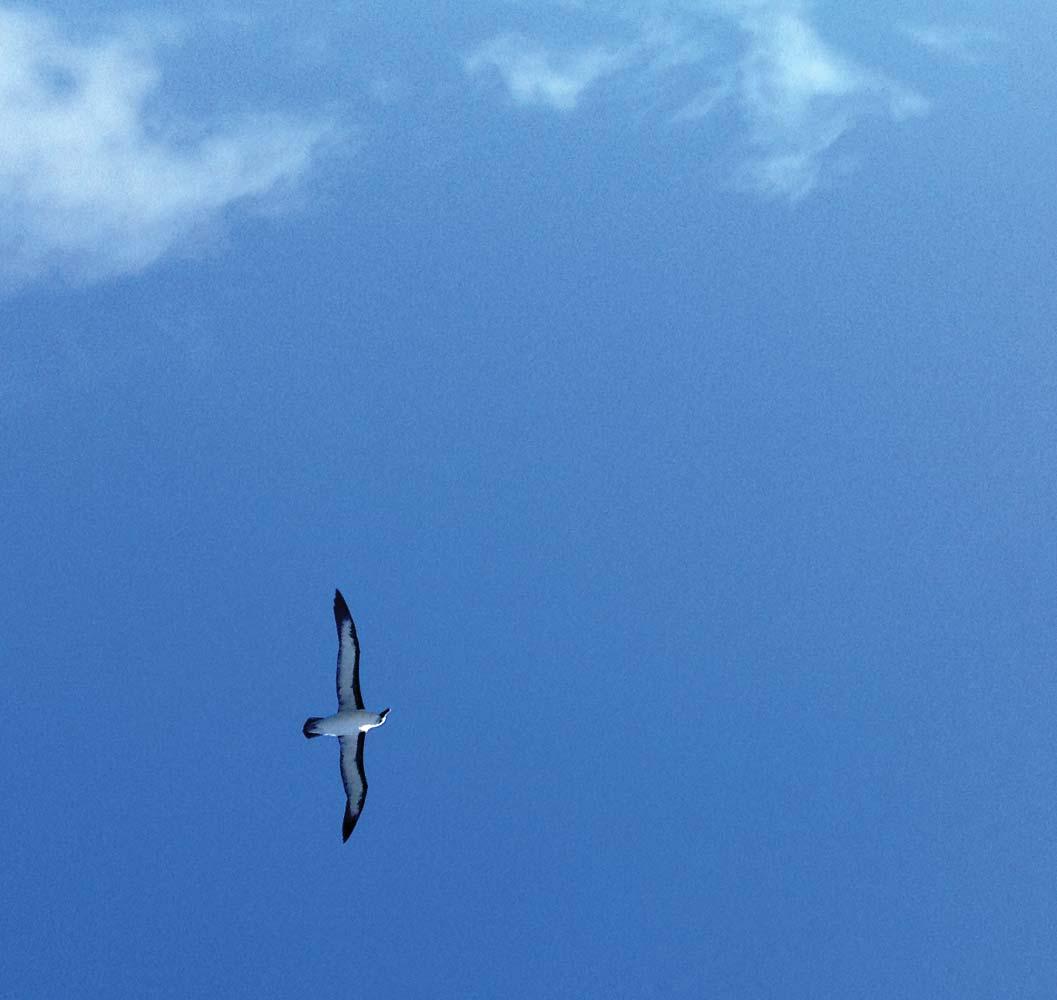
Like Moitessier, Seaburban’s constant companions are the albatross
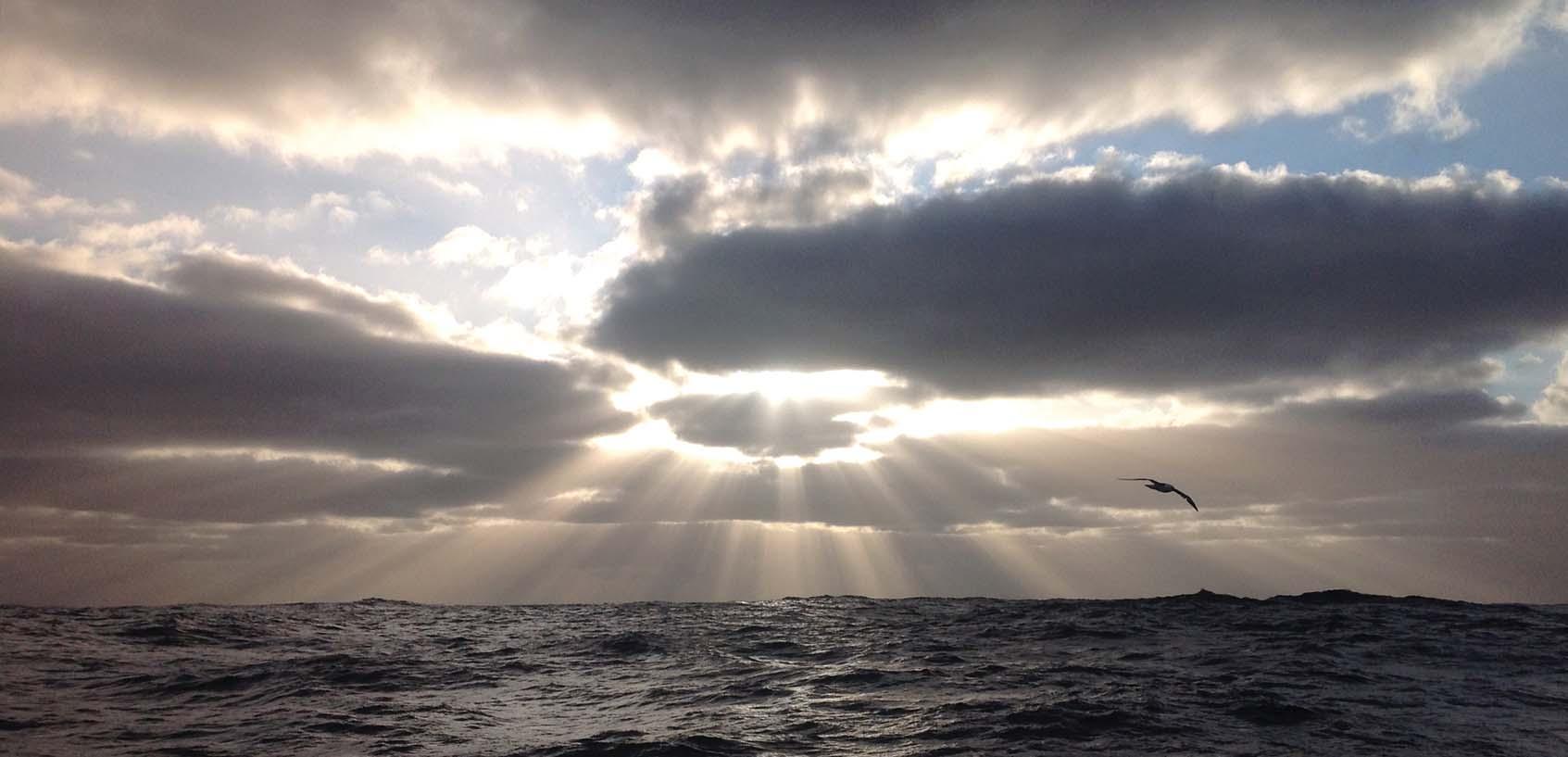
by a massive Southern Ocean storm immediately after passing under Tasmania’s South East Cape, my track to New Zealand’s South Cape was now cast in stone. The detour north was unavoidable, and now I needed all the sea room I dared take as storms astern and south of me forced my hand. I sailed straight for South Cape, and pushed Seaburban as hard as I dared in steadily building seas and wind as the weather deteriorated in fits and starts over the better course of a week. I had sailed most of the way across the south Tasman Sea with very little to reassure my navigation. Sun shots were few and far between and the few sights I did get were hampered by rough seas, indistinct horizons and hurried shots. I was more than nervous as I pored over the paper charts I had for the area immediately south of Stewart Island. The Traps and Snares, the islands I was aiming to miss, seemed aptly named and didn’t inspire confidence.

Conditions harden as Seaburban crosses under Australia and heads deeper into the Roaring Forties

Tools of the trade – slide rules, the laminated S-Tables, customized work forms and plotting sheets. I spent at least two hours each day navigating

During a shakedown cruise to Alaska I practise the dead reckoning and plotting I would need to master before attempting a celestial-only circumnavigation. Photo Nani Belle Browne
The worsening weather and seas had me doubly concerned about crossing the shallows that extend out from Stewart Island. With my navigation in doubt, I was feeling pressed either to throw caution to the wind and attempt crossing the bank, or take a much longer route in far deeper water south of Campbell Island. I wasn’t keen on the idea of crossing the Solander Trough in a gale hounded by a large and confused Southern Ocean sea. Depths in the Trough are in the order of 2500m rising to less than 140m in about 20 miles. Tidal currents opposing gale-force wind and waves, a steeply shoaling continental shelf and an uncertain landfall do not bode well for safe passage. I well remembered Jeanne Socrates heaving to and waiting for favourable weather in her latest, extraordinary, success before rounding South Cape, but for the life of me I couldn’t remember what Randall Reeves had done on his two roundings of South Cape while pursuing the incomparable Figure 8 Voyage. So I reached out to Randall and asked.
Like Tony before, Randall responded almost instantly. Yes, he had dared cross the shallow bank. He had, in fact, lain becalmed within sight of Stewart Island on his second passage south of New Zealand. He gave me the latitude and longitude of the North and South Traps as well as of the Snares. The storm looming behind and another far worse to the south made the decision for me – I transposed the lat and long of the Traps and Snares onto a plotting sheet, drew in danger bearings, and put the proverbial pedal to the metal.
I was lucky enough to get a decent running-fix* of the sun while still in deep water. This last piece in place, I took the time to secure the boat for storm conditions and then focused on keeping Seaburban moving as fast as the Monitor would allow. My passages through the southern Indian Ocean and south Tasman Sea had taught me

Gybing downwind between danger bearings, Seaburban’s track closes in on the Traps and Snares
* A running-fix can be used to estimate a vessel’s position when simultaneous observations are not possible. A single line of position is determined, and a careful record of course, time and speed (or distance) is maintained. A second line of position is determined and the first is advanced, or run up to, the second. Advancing the first to the second is done along the track the vessel has maintained between the two observations.
to weigh boat speed against steering loads. Too fast and the Monitor couldn’t cope or would get behind and Seaburban would broach or, worse, gybe. Too slow and the Monitor could not stop her from lying a-hull and getting savagely hammered by cresting and breaking waves.
As luck would have it I crossed into shallow water with both the tide and the Antarctic Circumpolar Current helping. It was almost anticlimactic as the seas mellowed despite the gale. While still in deep water, swell from three different directions and winds gusting well above gale-force had made for a chaotic, confused sea. On the bank it seemed like a holiday and, for the first time in months, the sea no longer snapped at Seaburban like some angry, rebuked minion. It was a welcome, unexpected relief and stamped on those few hours the realisation that I had actually, unbelievably, successfully sailed south of the Five Great Capes.
The model forecasts called for a significant strengthening of the gale that was following me as it crossed over the South Island. A different, more severe gale tracking eastward near 50°S would force me north. My plans for easting in the prevailing westerlies of the Roaring Forties once again took a turn for the worse as I resolutely pointed Seaburban north and east.

Hard on the wind and clawing north, and eventually northby-west, I work Seaburban around a gale that refuses to move off to the east

Upwind against the South East and then North East Trades proves to be the last consequential hurdle. Missing her largest jib, the slog upwind against the Trades adds at least ten days to the trip
Given a chance to reflect on passing south of New Zealand, I realised I no longer had the single-minded focus on the ‘next one’. There were no next Capes – all five were behind me. I had not put nearly as much thought into the final part of the voyage as I put into every other and it came as a bit of a shock. I had been slow up to this point and was seriously behind schedule – clearly, I wasn’t getting home and completing the circuit in anything under 250 days. With the Southern Hemisphere winter fast approaching, I figured it was time to put conservatism aside and push for home. Home would be the goal now. Not another Cape, but Home. The decision to push seemed timely and I thought the passage up the Pacific would be less of an ordeal than the previous oceanic transits. I’m sure somewhere Thomas Gray was smiling. It was he who, in 1742, penned, ‘Where ignorance is bliss, ‘tis folly to be wise’.
Southwest of Chatham Island, about 270 miles east of New Zealand, the jib halyard parted, putting that sail out of service until I could get up the mast and reeve a new halyard. I had already been up the mast twice and knew full well the conditions needed to make a success of it. I thought that, when closer to the Trades, or surely the Doldrums, I would get lucky with the conditions. Unfortunately they never materialised and Seaburban was forced to rely on her 70% Solent to get her the remaining 6000, mostly upwind, miles home. At 280ft2 it’s a far cry from the 480ft2 110% jib that I flew on the forestay north of 35°S or the 400ft2 90% Yankee I flew south of 35°S. The loss of both of those jibs added something like ten days to the circumnavigation.
The End: Victoria, British Columbia, 18th July 2020
In fact, the passage up the Pacific was anything but easy. Running out of food and water, Seaburban crippled without the use of her most powerful sail and thousands of miles sailed dead upwind had taken their toll. Both the boat and I were tired, and it was beginning to show in the carefully-constructed and rigidly adhered-to routines that had kept me safe for tens of thousands of miles and more than 200 days. Moreover, I was getting more and more anxious about returning to a world I no longer knew.
COVID-19 had locked down Australia, New Zealand, Polynesia, the US and, of course, Canada in the months since my departure – I was welcome back in Canada and nowhere else. The Shoreteam had inquired about landfall in other countries in case of damage or emergency but the answer was always an unambiguous, emphatic ‘No!’. It was Canada or bust. But Canada, and in particular British Columbia, was not welcoming me back with particularly open arms. A mandatory 14 days of quarantine and self-isolation looked to be a certainty. We were told by the Canadian Border Services Agency that no one would be allowed on the dock, and any group present at my arrival had to be less than 20 people and most likely limited to six. With only the boat and myself to worry about for close to nine months I was overwhelmed and more than a little confused by the onslaught of rules and regulations imposed by the new normal. I rebelled and railed at none but myself as I sailed over the North Pacific High and headed due east for home.
The closer I got to home, the more anxious I became about what was in store. Everyone had expected that I would return a changed man. No one, including me, imagined

I wave excitedly to a handful of friends and family while Seaburban floats some 100 yards off Saxe Point, British Columbia

Arriving at the Customs dock, 265 days after departing the Royal Victoria Yacht Club. Photo Dr Don Butt
that the world I would return to would be nearly unrecognisable. Already a bit of a square peg in a world of mostly round holes, I imagined the new normal as something to avoid at all costs. Daily visits and phone calls from the Shoreteam to the offices of the Superintendent of the Canadian Border Services Agency proved fruitless. Letters written on my behalf to Dr Bonnie Henry, British Columbia’s Chief Medical Officer and architect of its COVID-19 response plan, went unacknowledged let alone answered. My introduction to COVID-19 would be both swift and brutal.
In the end the Shoreteam, and in particular my sister Leah, pleaded with me to let events unfold as they would – perhaps my luck would hold. After all, had Lady Luck not smiled on every aspect of the voyage to date? I relented and focused on getting Seaburban into and through the Straits of Juan de Fuca without incident. It proved sage advice. At the entrance to Juan de Fuca the wind shut off as if someone had hit a switch and I drifted rather than sailed the last miles past Race Rocks as the tides, calms and currents had their way with me. Dodging some 40-odd recreational fishing boats while the current poured through Race Passage, the last obstacle en route to the waters surrounding Victoria from the west, I gave little thought to Canadian Customs and less still to the end of the voyage.
By noon local time on 18th July I could just make out the blue dots on the slopes above Saxe Point. The blue dots were family and a very few, very precious friends wearing Five Capes T-shirts. Nothing could have prepared me for the emotions that flooded through me when I realised what I was looking at. The voyage was at an end, and a successful end at that. Customs could do their worst – it would not matter in the least.
Landing at the Customs dock in Victoria Harbour, I stepped ashore and suddenly, unbelievably, I was no longer at sea but at home. Home, as Robin Knox-Johnston had written in A World of My Own, was no longer an abstraction but a reality, albeit
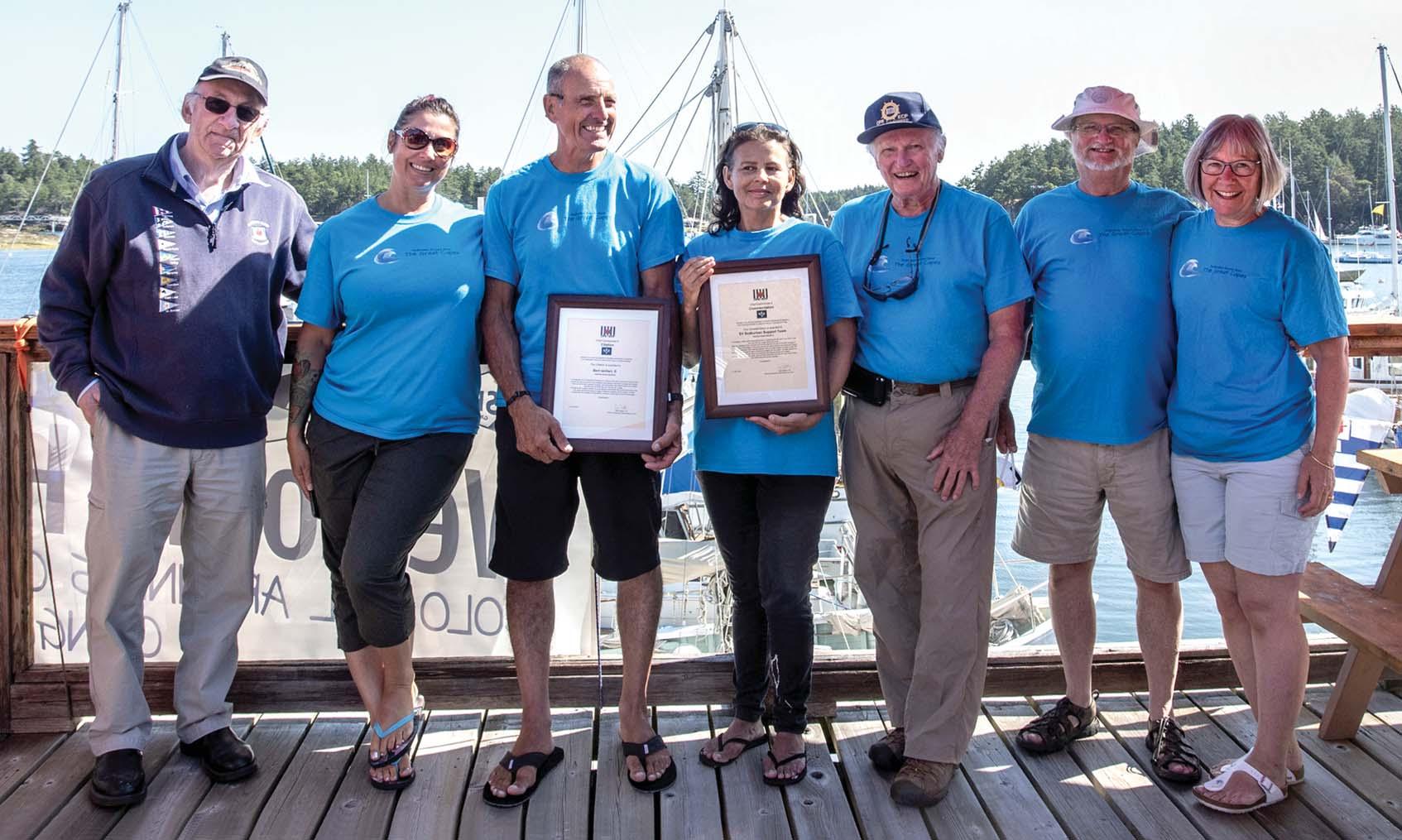
With the 5Capes.com Shoreteam at Silva Bay Marina, Gabriola Island. L to r: Peter Bolton, Chief Commander of the Canadian Power Squadron; Leah ter Hart, Shoreteam Manager; Nani Belle Browne, my wife; Dr Don Butt, MD; John Bullas, family friend and retired meteorologist; Sally Bullas, family friend. Photo Mary Butt
drastically changed and somewhat unrecognisable. Clearance proceeded in a comical, other-worldly fashion as I fumbled with a mask and then laboured to grasp and then sign off on the dozen or so pages of COVID-19 isolation rules, regulations and associated fines and penalties. I pleaded my case as forcibly as protocol would allow and, with the decision out of the Customs Officers’ hands and squarely in the court of some Public Health Official 4500km away in Ottawa, I made small talk about the size of the waves in the Southern Ocean. In no time flat, a very surprised Customs Officer returned to tell me I would not be quarantined – I was, in fact, free to go. I smiled ear-to-ear beneath my mask and I’m sure the officers were smiling as well. The news spread quickly to the small group of family and friends who had gathered on the other side of the locked, plexiglass gate which had served to separate me from the rest of the world. Once unlocked and held open by what had been my jailers only moments before, I stepped ashore and, at long last, arrived back home.
It is impossible to understate the support of my family and friends, as well as the thousands who followed my circumnavigation on social media. There was always someone ready and willing to pick me up when I needed it most. Without the support and encouragement of the OCC and its executive, and especially of Tony Gooch, Randall Reeves, and Rick Whiting, there is simply no way that my circumnavigation could have unfolded as it did. I cannot thank the OCC, the Challenge Grant Awards Committee and those members mentioned above enough. I owe a debt that I am unsure I will ever be able to repay.
A few notes on navigation:
I used a Cassens and Plath Horizon Ultra sextant. For back-up, I carried a Freiberger drum sextant and a Bris sun-repeater. The Cassens is a wonderful instrument with superior optics. I was extremely careful, however, to keep it as free as possible from spray as I did not carry spare mirrors. Neither the Freiberger nor the Bris saw active service. (For more about the Bris sun-repeater visit https://www.yrvind.com/brissextant-for-sale/.) Although I carried HO Pubs 229, 249, 208 and 211 I never used them and I worked my sights exclusively with S-Tables. These are extremely compact (nine pages total) and small, and before I left I laminated mine to ensure they were waterproof. To make their use simpler still, I developed custom forms to work my sights. Lastly, I carried Stark’s solutions to the Lunar Distance problem to work out times and therefore longitude in case of a complete collapse in timekeeping. Luckily, I never resorted to them for anything other than amusement.

SELL YOUR YACHT WITH JOHN RODRIGUEZ YACHTS
“A first class brokerage service with standards of excellence rarely found in the industry” y” Specialist blue water & cruising yacht broker Fe llow Members Recei ve Ocean Cruising Clu b 10% OCC Discount
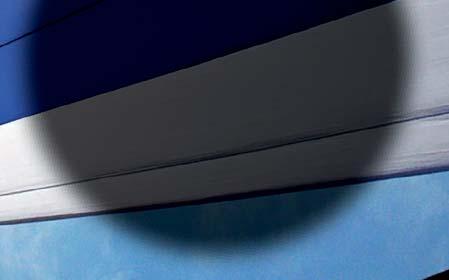

www.jryachts.com e: info@jryachts.com Tel: +44 (0)7505 485 950











